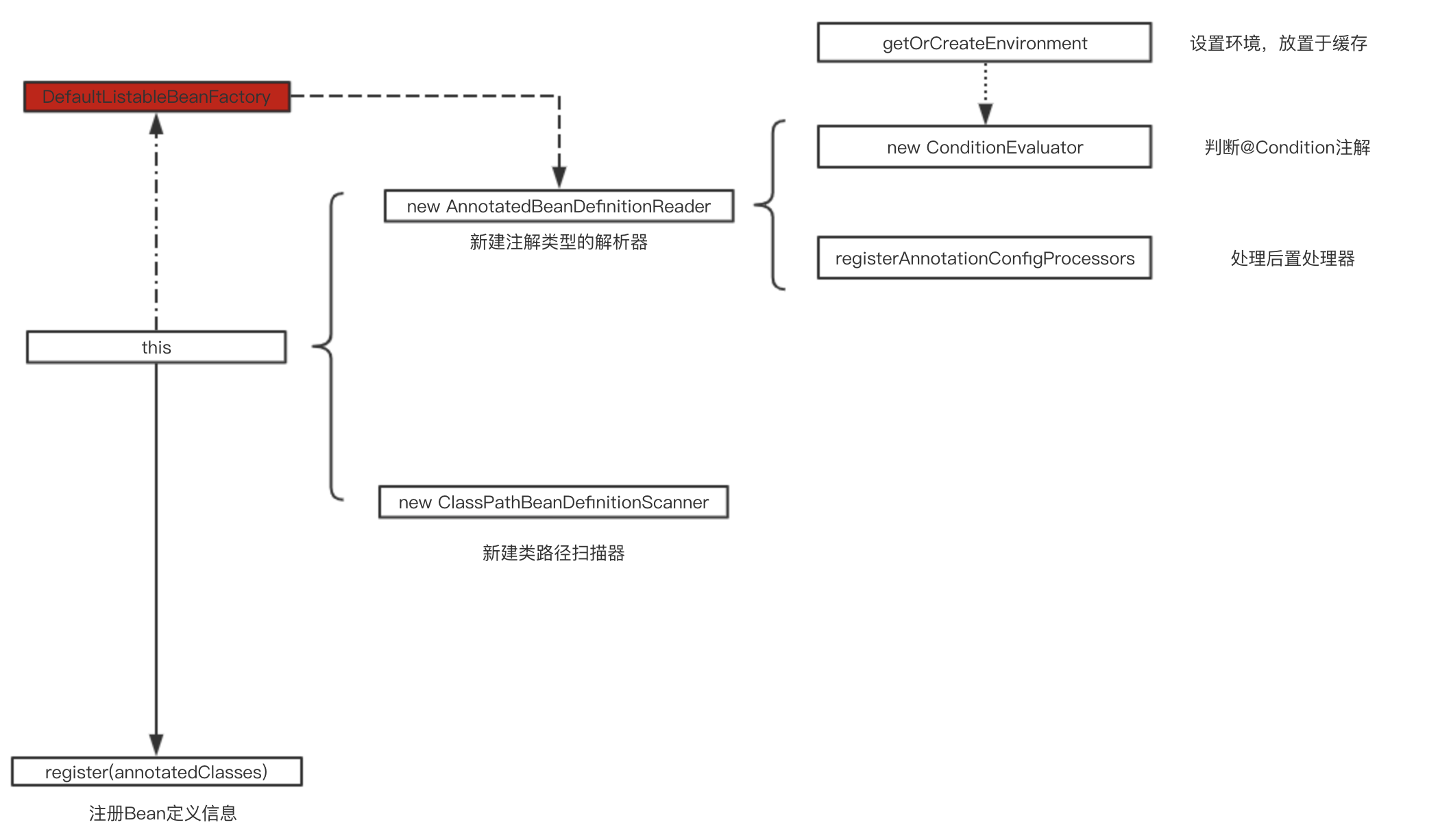java架构之路-(spring源码篇)springIOC容器源码解析(上)
我们这次来叭叭一下Spring的源码,这次博客主要来说说Spring源码,先粗略的撸一遍,下篇博客选几个重点去说,由于过于复杂,我也是看了一点点,我们先来过一遍源码,然后上流程图,最后我们再回头总结一下,我们来循序渐进的叭叭一下。
我们来回顾一下上次Spring博客的内容,每次都有用到AnnotationConfigApplicationContext来加载我们的配置类,我们就从这里开始。
/**
* Create a new AnnotationConfigApplicationContext, deriving bean definitions
* from the given annotated classes and automatically refreshing the context. 创建新的注释configapplicationcontext,获得bean定义并自动刷新上下文。
* @param annotatedClasses one or more annotated classes, 我们的配置类
* e.g. {@link Configuration @Configuration} classes
*/
public AnnotationConfigApplicationContext(Class<?>... annotatedClasses) {
this();
register(annotatedClasses);
refresh();
}
翻译过来就是“创建新的注释configapplicationcontext,获得bean定义并自动刷新上下文”。三个方法,我们先来一个个看,优先看父类有没有构造方法。AnnotationConfigApplicationContext继承了GenericApplicationContext类,所以我们先看GenericApplicationContext类的构造方法。代码很简单
父类构造方法
/**
* Create a new GenericApplicationContext.
* @see #registerBeanDefinition
* @see #refresh
*/
public GenericApplicationContext() {
this.beanFactory = new DefaultListableBeanFactory();
}
这里创建了一个新的DefaultListableBeanFactory对象,也是我们熟悉的beanFactory对象,记住是DefaultListableBeanFactory对象。我们回到AnnotationConfigApplicationContext的this方法。
this
/**
* Create a new AnnotationConfigApplicationContext that needs to be populated
* through {@link #register} calls and then manually {@linkplain #refresh refreshed}.
*/
public AnnotationConfigApplicationContext() {
this.reader = new AnnotatedBeanDefinitionReader(this);//注解类型的解析器
this.scanner = new ClassPathBeanDefinitionScanner(this);//包扫描器
}
再往下扒一层。看一下那个AnnotatedBeanDefinitionReader注解类型的解析器是怎么创建的,里面都有什么。
/**
* Create a new {@code AnnotatedBeanDefinitionReader} for the given registry.
* If the registry is {@link EnvironmentCapable}, e.g. is an {@code ApplicationContext},
* the {@link Environment} will be inherited, otherwise a new
* {@link StandardEnvironment} will be created and used.
* @param registry the {@code BeanFactory} to load bean definitions into,
* in the form of a {@code BeanDefinitionRegistry}
* @see #AnnotatedBeanDefinitionReader(BeanDefinitionRegistry, Environment)
* @see #setEnvironment(Environment)
*/
public AnnotatedBeanDefinitionReader(BeanDefinitionRegistry registry) {
this(registry, getOrCreateEnvironment(registry)); //优先设置了环境并存在缓存内
}
设置了环境,将我们的beanFactory作为参数,做了this调用,
/**
* Create a new {@code AnnotatedBeanDefinitionReader} for the given registry and using
* the given {@link Environment}. 用registry和Environment创建一个新的AnnnotatedBeanDefinitionReader
* @param registry the {@code BeanFactory} to load bean definitions into,
* in the form of a {@code BeanDefinitionRegistry}
* @param environment the {@code Environment} to use when evaluating bean definition
* profiles.
* @since 3.1
*/
public AnnotatedBeanDefinitionReader(BeanDefinitionRegistry registry, Environment environment) {
Assert.notNull(registry, "BeanDefinitionRegistry must not be null");
Assert.notNull(environment, "Environment must not be null");
this.registry = registry;
this.conditionEvaluator = new ConditionEvaluator(registry, environment, null);
AnnotationConfigUtils.registerAnnotationConfigProcessors(this.registry);
}
前三行不用看,第四行是用来解析我们@Conditional注解的。可以自己打开瞧瞧源代码。我们直接看第五行AnnotationConfigUtils.registerAnnotationConfigProcessors(this.registry); 也是很重要的代码,我们继续叭叭。
/**
* Register all relevant annotation post processors in the given registry.
* @param registry the registry to operate on
* @param source the configuration source element (already extracted)
* that this registration was triggered from. May be {@code null}.
* @return a Set of BeanDefinitionHolders, containing all bean definitions
* that have actually been registered by this call
*/
public static Set<BeanDefinitionHolder> registerAnnotationConfigProcessors(
BeanDefinitionRegistry registry, @Nullable Object source) { DefaultListableBeanFactory beanFactory = unwrapDefaultListableBeanFactory(registry);
if (beanFactory != null) {
if (!(beanFactory.getDependencyComparator() instanceof AnnotationAwareOrderComparator)) {
beanFactory.setDependencyComparator(AnnotationAwareOrderComparator.INSTANCE);
}
if (!(beanFactory.getAutowireCandidateResolver() instanceof ContextAnnotationAutowireCandidateResolver)) {
beanFactory.setAutowireCandidateResolver(new ContextAnnotationAutowireCandidateResolver());
}
} Set<BeanDefinitionHolder> beanDefs = new LinkedHashSet<>(8); if (!registry.containsBeanDefinition(CONFIGURATION_ANNOTATION_PROCESSOR_BEAN_NAME)) {
RootBeanDefinition def = new RootBeanDefinition(ConfigurationClassPostProcessor.class);
def.setSource(source);
beanDefs.add(registerPostProcessor(registry, def, CONFIGURATION_ANNOTATION_PROCESSOR_BEAN_NAME));
} if (!registry.containsBeanDefinition(AUTOWIRED_ANNOTATION_PROCESSOR_BEAN_NAME)) {
RootBeanDefinition def = new RootBeanDefinition(AutowiredAnnotationBeanPostProcessor.class);
def.setSource(source);
beanDefs.add(registerPostProcessor(registry, def, AUTOWIRED_ANNOTATION_PROCESSOR_BEAN_NAME));
} // Check for JSR-250 support, and if present add the CommonAnnotationBeanPostProcessor.
if (jsr250Present && !registry.containsBeanDefinition(COMMON_ANNOTATION_PROCESSOR_BEAN_NAME)) {
RootBeanDefinition def = new RootBeanDefinition(CommonAnnotationBeanPostProcessor.class);
def.setSource(source);
beanDefs.add(registerPostProcessor(registry, def, COMMON_ANNOTATION_PROCESSOR_BEAN_NAME));
} // Check for JPA support, and if present add the PersistenceAnnotationBeanPostProcessor.
if (jpaPresent && !registry.containsBeanDefinition(PERSISTENCE_ANNOTATION_PROCESSOR_BEAN_NAME)) {
RootBeanDefinition def = new RootBeanDefinition();
try {
def.setBeanClass(ClassUtils.forName(PERSISTENCE_ANNOTATION_PROCESSOR_CLASS_NAME,
AnnotationConfigUtils.class.getClassLoader()));
}
catch (ClassNotFoundException ex) {
throw new IllegalStateException(
"Cannot load optional framework class: " + PERSISTENCE_ANNOTATION_PROCESSOR_CLASS_NAME, ex);
}
def.setSource(source);
beanDefs.add(registerPostProcessor(registry, def, PERSISTENCE_ANNOTATION_PROCESSOR_BEAN_NAME));
} if (!registry.containsBeanDefinition(EVENT_LISTENER_PROCESSOR_BEAN_NAME)) {
RootBeanDefinition def = new RootBeanDefinition(EventListenerMethodProcessor.class);
def.setSource(source);
beanDefs.add(registerPostProcessor(registry, def, EVENT_LISTENER_PROCESSOR_BEAN_NAME));
} if (!registry.containsBeanDefinition(EVENT_LISTENER_FACTORY_BEAN_NAME)) {
RootBeanDefinition def = new RootBeanDefinition(DefaultEventListenerFactory.class);
def.setSource(source);
beanDefs.add(registerPostProcessor(registry, def, EVENT_LISTENER_FACTORY_BEAN_NAME));
} return beanDefs;
}
原文的注释为在给定的注册器中处理所有有意义的后置处理器,基本就是是否包含***,如果包含就set进去。这段代码是用来初始化内部的组件的。走到这里就已经初始化的Bean定义。也就是说我们的容器已经注入了定义信息,还未实例化。
this方法的上半部分就说完了,我们再来看下半部分的new ClassPathBeanDefinitionScanner,创建一个类路径扫描器,这个代码不多,就是判断我们是否使用默认的类路径扫描器。
/**
* Create a new {@code ClassPathBeanDefinitionScanner} for the given bean factory and
* using the given {@link Environment} when evaluating bean definition profile metadata.
* @param registry the {@code BeanFactory} to load bean definitions into, in the form
* of a {@code BeanDefinitionRegistry}
* @param useDefaultFilters whether to include the default filters for the
* {@link org.springframework.stereotype.Component @Component},
* {@link org.springframework.stereotype.Repository @Repository},
* {@link org.springframework.stereotype.Service @Service}, and
* {@link org.springframework.stereotype.Controller @Controller} stereotype annotations
* @param environment the Spring {@link Environment} to use when evaluating bean
* definition profile metadata
* @param resourceLoader the {@link ResourceLoader} to use
* @since 4.3.6
*/
public ClassPathBeanDefinitionScanner(BeanDefinitionRegistry registry, boolean useDefaultFilters,
Environment environment, @Nullable ResourceLoader resourceLoader) { Assert.notNull(registry, "BeanDefinitionRegistry must not be null");
this.registry = registry; if (useDefaultFilters) {
registerDefaultFilters();
}
setEnvironment(environment);
setResourceLoader(resourceLoader);
}
我们来直接看一下第23行代码,是否注册一个默认的过滤器(扫描策略)。25行设置环境,26行设置资源加载器。
到这里就已经制定好了我们的扫描策略了。
有点乱啊梳理一下。

register(annotatedClasses)
this部分就说你完了,再来看看register(annotatedClasses);字面意思来看是带着我们的配置文件注册,我们来看一下代码。
/**
* Register one or more annotated classes to be processed.
* <p>Note that {@link #refresh()} must be called in order for the context
* to fully process the new classes.
* @param annotatedClasses one or more annotated classes,
* e.g. {@link Configuration @Configuration} classes
* @see #scan(String...)
* @see #refresh()
*/
public void register(Class<?>... annotatedClasses) {
Assert.notEmpty(annotatedClasses, "At least one annotated class must be specified");
this.reader.register(annotatedClasses);
}
用我们上一步的reader解析器去注册,里面是一个循环方法。最终调用doRegisterBean来真正的注册。这一步我们先来简单的叫做注册吧。

直到这里其实我们容器还是没有创建的,这些都是一些前期的准备工作。最后也是最关键的一步才是我们的容器的实例化。refresh()方法。内容超多。
@Override
public void refresh() throws BeansException, IllegalStateException {
synchronized (this.startupShutdownMonitor) {
// Prepare this context for refreshing.
prepareRefresh(); // Tell the subclass to refresh the internal bean factory.
ConfigurableListableBeanFactory beanFactory = obtainFreshBeanFactory(); // Prepare the bean factory for use in this context.
prepareBeanFactory(beanFactory); try {
// Allows post-processing of the bean factory in context subclasses.
postProcessBeanFactory(beanFactory); // Invoke factory processors registered as beans in the context.
invokeBeanFactoryPostProcessors(beanFactory); // Register bean processors that intercept bean creation.
registerBeanPostProcessors(beanFactory); // Initialize message source for this context.
initMessageSource(); // Initialize event multicaster for this context.
initApplicationEventMulticaster(); // Initialize other special beans in specific context subclasses.
onRefresh(); // Check for listener beans and register them.
registerListeners(); // Instantiate all remaining (non-lazy-init) singletons.
finishBeanFactoryInitialization(beanFactory); // Last step: publish corresponding event.
finishRefresh();
} catch (BeansException ex) {
if (logger.isWarnEnabled()) {
logger.warn("Exception encountered during context initialization - " +
"cancelling refresh attempt: " + ex);
} // Destroy already created singletons to avoid dangling resources.
destroyBeans(); // Reset 'active' flag.
cancelRefresh(ex); // Propagate exception to caller.
throw ex;
} finally {
// Reset common introspection caches in Spring's core, since we
// might not ever need metadata for singleton beans anymore...
resetCommonCaches();
}
}
}
我们来逐个方法看一下都是做什么的。
prepareRefresh()创建早期程序监听器。
ConfigurableListableBeanFactory beanFactory = obtainFreshBeanFactory()通知子类刷新Bean工厂
prepareBeanFactory(beanFactory)配置工厂上下文。
postProcessBeanFactory(beanFactory)处理Bean工厂的后置处理
invokeBeanFactoryPostProcessors实例化并调用所有注册的Bean工厂的后置处理器
registerBeanPostProcessors(beanFactory)注册Bean工厂的后置处理器
initMessageSource()初始化消息源
initApplicationEventMulticaster()初始化事件多播器
onRefresh()初始化特殊定义的Bean
registerListeners()注册事件监听器
finishBeanFactoryInitialization(beanFactory)实例化剩余非懒加载Bean
finishRefresh()事件发布
resetCommonCaches()刷新缓存
就这样我们的Bean工厂就创建完成了。看着如此简单吧。后面我们来详细看一下。内部还有超多的东西。Spring源码不建议太过于深入的学习,容易陷进去....


最近搞了一个个人公众号,会每天更新一篇原创博文,java,python,自然语言处理相关的知识有兴趣的小伙伴可以关注一下。

最新文章
- 创建docker私人仓库
- Windows Server 2008 R2 安装 media Service 部分更新没有安装 KB963697
- Hyper-V初涉:Hyper-V虚拟机常规操作
- SAP中寄售处理
- centos 6.4 安装php-fpm 及常用扩展,(转)
- Jmeter初步使用三--使用jmeter自身录制脚本
- 作品第一课----改变DIV样式属性
- PHP - session编码和解码
- Spring加载XML机制
- docker:(4)利用WebHook实现持续集成
- 大数据 --> Kafka集群搭建
- Element-ui使用技巧
- AngularJS 1.x系列:AngularJS控制器(3)
- 浅谈个人对RAID技术的理解
- gtk界面设计
- Shell-脚本只能运行1次
- Mysql修改字段类型
- Java泛型的逆变
- 转:centos7.2安装jdk1.6和/etc/profile不生效问题
- Photon3Unity3D.dll 解析三——OperationRequest、OperationResponse